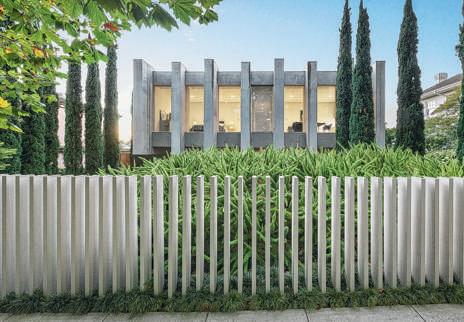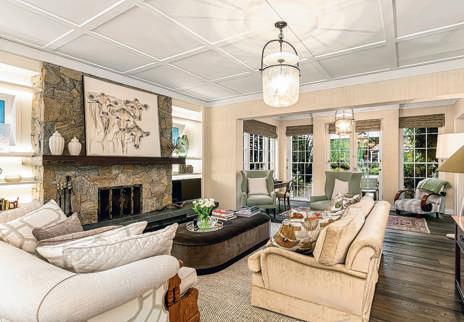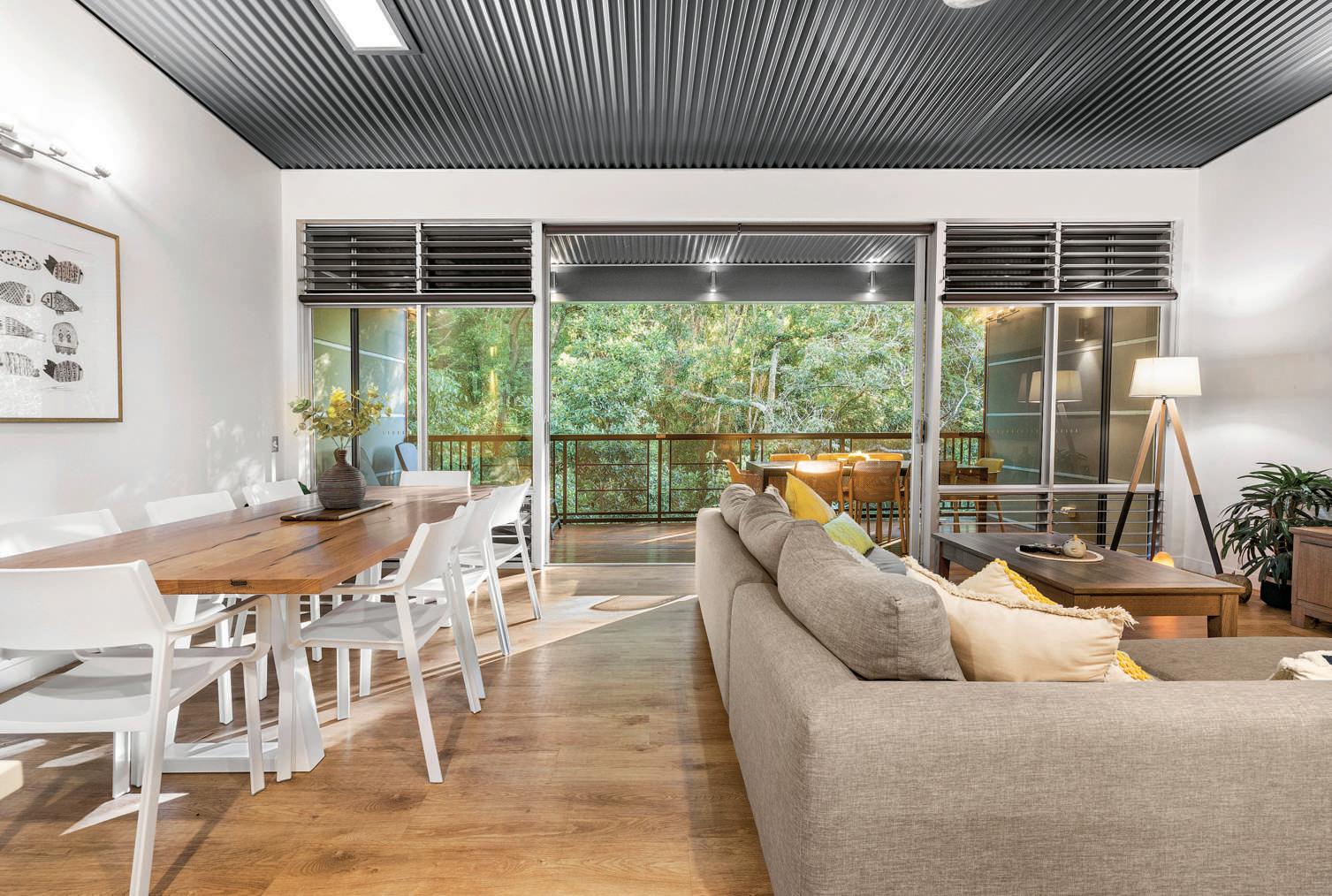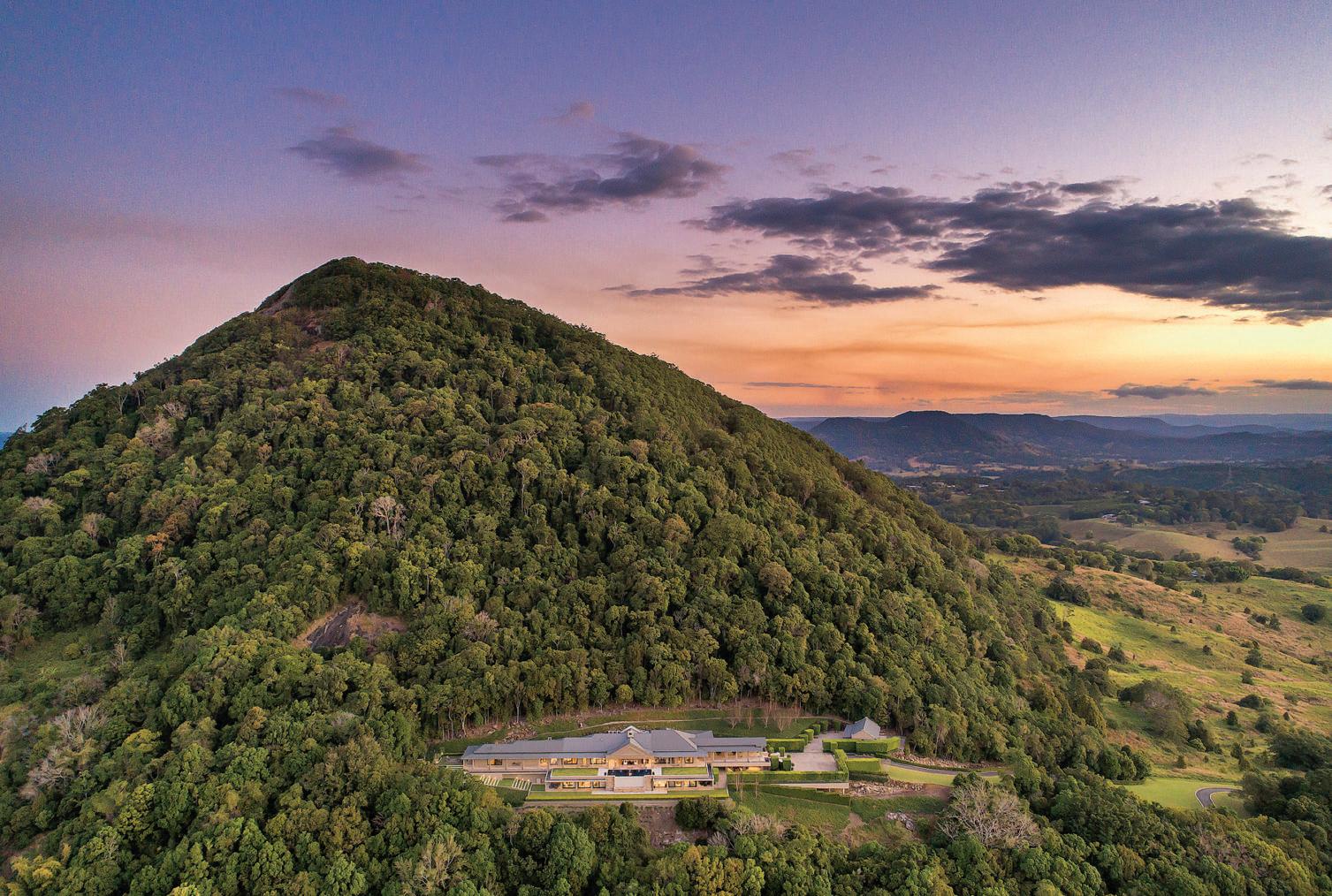
14 minute read
COVER
from Mansion April
MCover story
Melbourne’s prestige property market is well into its recovery from being the harshest hit capital city during the peak of the 2020 pandemic and much of the market is experiencing a renaissance.
Advertisement
Prices are typically exceeding the price guide, and in quick time.
“Smart buyers like rising markets,” Melbourne buyers’ agent Mal James advised recently. “Besides more choice, right now several of our buying clients will have $250,000 to $1.5 million in additional home equity between signature and settlement. A year on, possibly all our current clients will have better balance sheets than those who didn’t buy this weekend,” James says, adding it was often necessary for buyers to “push past the noise and act on an A-grader”.
Opinions vary on the firmness of the recovery, and there is some patchiness in some market segments.
James suggests the 2021 opening was statistically as “hot as it was in the opening market of 2016”.
“The only difference we can see is the C-graders are not selling as quickly or as much over reserve as in 2016,” he says.
Toorak has certainly been the hotbed of recovery among the Melbourne prestige suburbs, while the Mornington Peninsula’s performance has been stellar.
“Toorak is the epicentre of the big exchanges, but it’s not the only suburb – think Brighton and Hawthorn as well,” James says.
Toorak sales have included a 1930s Marcus Martin home at 6 Lascelles Avenue that changed hands last month after a renovation by Stephen Akehurst. It sold with an asking price of $12 million through RT Edgar Toorak agent Mark Wridgway, who had it listed in conjunction with Marshall White’s Marcus Chiminello. The five-bedroom home on 965sq m features a heated pool and cabana.
Brighton has seen 255 New Street go under offer in less than a month, having had $18 million to $19.8 million expectations through James Paynter agents James Paynter and Suzie Farrell, with an expat expressing the keenest interest. The fivebedroom home has a bowling alley, as well as a music studio, home office, gym, home cinema room and wine cellar.
The push for more space has also been seen in the outer Melbourne suburbs, which are now attracting strong interest.
There were more than 20 private inspections and five contracts issued in the first fortnight after 5 Homestead Road, Eltham, was listed in mid-March, with offers
RICH PICKINGS
Prestige living in post-lockdown Melbourne is hot property, with the state’s coastal hideaway now joining blue-chip suburbs in setting record sales with jaw-dropping prices
S tory by JONATHAN CHANCELLOR

This five-bedroom house at 255 New Street, Brighton, went under offer in less than a month






scheduled to close next week. Aaron Yeats at Jellis Craig North East gave a guide of $2.75 million to $2.95 million for the fivebedroom, five-bathroom English Gothic style homestead. He’s marketed the property, which last sold in 2005 for $830,000, as having “the charisma of Montsalvat and the luxury of today”.
“It is clear the market for large homes in suburbs such as Ivanhoe and Eaglemont – as well as larger land holdings in suburbs such as Lower Plenty, Eltham and Kangaroo Ground –have seen some significant results as people appear to be yearning for more space and a lifestyle change,” Yeats says.
“Across the Ivanhoe, Eaglemont, Ivanhoe East market, the first quarter last year sales in excess of $1.5 million are actually lower (35 sales in 2020 vs 26 sales in 2021), so we are finding that we cannot find enough homes.”
The Mornington Peninsula has been the state’s best performer, according to realestate.com.au chief economist Nerida Conisbee. She notes that it has pivoted from being a second home area, and more recently a seachange destination, to a location ideal for those now working remotely.
REA Group calculated there was a 12.5 per cent increase on the peninsula in the year to February, which followed two prior annual gains of 1.2 per cent and 5.05 per cent.
The peninsula is the only one of eight key local government areas to achieve three consecutive years of growth. Melbourne’s largest growth locations for median house prices have been in Flinders and Red Hill, both on the peninsula.
“We have seen evidence of prime Portsea properties increasing by 20 per cent in a six-month period – it’s quite astonishing,” HTW valuer Perron King says.
Recent peninsula sales have included Mount Clear, a Sorrento home snapped up when put on the market for the first time in 27 years. The five-bedroom home on Constitution Hill Road sits on 1365sq m, one of three blocks offered as part of a total 4375sq m. Kay & Burton’s Gerald Delany and Liz Jensen secured the sale in just over a month.
King notes that the Melbourne market sprang to life after stage four restrictions were lifted in October/November, with the exception of Portsea/Sorrento, where properties had remained strong. “Typically, after Christmas the market takes a break as we all head off to the beach,” King says. “This summer was unprecedented in terms of having peak spring activity to it and this has continued into autumn.
“It is the busiest I’ve seen in the prestige space for this period in 20 years in terms of refinancing and transactions.”
“Right now premium property is doing exceptionally well, and with economic growth returning we are looking at boom time conditions,” Conisbee says.
“The Melbourne luxury boom started a bit later than other capital cities, primarily because of the extended lockdown; however it does appear to have recovered very quickly,” she says. “The extended lockdown in Melbourne impacted the luxury end of the market. Elsewhere in Australia, we saw very strong conditions across all luxury property markets over the pandemic. This year, Melbourne will catch up.”
Demand has come predominantly from the traditional local high net worth buyer, although it appears there is increasing interest from expatriates returning from the UK, US and Asia.
The latest Toorak home to hit the market is 20 Linlithgow Road, billed as a modern masterpiece, by architect Stephen Jolson. The modern interpretation of the traditional family home took three years to build, providing 1250sq m of luxurious internal accommodation.
“It is akin to a 7-star hotel,” RT Edgar Toorak listing agent Antoinette Nido says.
The home, on 1270sq m, has four bedrooms and a lower level devoted to entertainment, with a 20m heated indoor pool, steam room and gym.
“The trend of last year and this year continues to prove Toorak to be the best prestige suburb for volume sales, and highest sale price. The prestige market has really rebounded post lockdown,” Nido says, citing 19 sales above $10 million since November 2020.
There have been seven sales greater than $20 million.
“To put this in historical perspective, there have only ever been six sales greater than $20 million in Toorak. South Yarra comes in at a close second for volume of prestigious property sales and high sales prices.”
King notes that two years ago, a $20 million sale in Toorak or Portsea was significant. “They are now occurring with much more frequency, and even in the mid-tier prestige segment of $5 million to $10 million, the volume of sales has significantly increased through all segments,” he says.
“Portsea was once considered highly volatile, with reductions of up to 40 per cent in the Global Financial Crisis downturn.
“It’s unlikely we will see that level of volatility returning, with current market fundamentals and a shift to regional living. However, markets are cyclical, and with every upswing there is a correction. When and by how much is the unknown.”
Nido says while these stellar suburbs are strong performers the momentum has spilled over into surrounding suburbs, with RT Edgar Toorak achieving strong prices in Malvern East, $8.7 million; Malvern, $7.85 million; East Melbourne, $7.3 million; Prahran, $6.46 million and Richmond, $4.6 million.
There was a recent suburb record sale in Richmond. Comedian Hamish Blake and his entrepreneurial wife Zoe Foster Blake sold their Melbourne home at 79a Rowena Parade for $7.435 million – well above the guide of $5.9 million to $6.3 million. The now Sydneysiders secured the sale of the home, which was designed by Neil Architecture and appeared on Grand Designs Australia, in just two weeks through Jellis Craig agent Carla Fetter.
Kay & Burton’s Michael Gibson notes that while the marketplace is known to be driven by three life events – death, divorce and debt – a fourth driver has been added in the past six to 12 months, which is the huge emphasis on making lifestyle changes as a result of the pandemic.
King advises the fundamentals are strong in prestige property in Melbourne and regional Victoria.
“The market has stated that it loves Melbourne and Victoria in the face of a global pandemic,” he says.
“However, the market is a confidence game and it is macroeconomic factors that will put on the handbrake – so any restrictions on credit, rising unemployment, inflation and rising interest rates. When is the unknown. Previous boom cycles have lasted from six to 30 months.”
It is obvious to buyers’ agent James that “the homes that present a ready-to-move-in, shiny new lifestyle are “Top of the Pops.”
“From Sorrento to Aspendale to Brighton to Queensland, from Toorak to the country, buyers are looking for the beach, for the air, for freedom,” he says.
“And they don’t want to wait – they don’t want to renovate.”
Top row: 6 Lascelles Avenue, Toorak Middle row: 5 Homestead Road, Eltham Bottom row: 20 Linlithgow Road, Toorak

Dolly Lenz
WITH JENNY LENZ

A dedicated fitness area is now an essential space in many luxury residential properties
HEALTHY LIVING
Home gyms raise the bar
Over the past year, the real estate industry has seen several interesting trends emerge that can be directly attributed to the effects and impact of the global pandemic.
As COVID-19 dramatically altered the daily lives and routines of consumers, a shift in what features buyers prioritised in their next home began to take hold throughout markets across the US. Driven by a desire for healthy living, home gyms have skyrocketed to the top of many wish lists and are now an irreplaceable amenity of any luxury home.
Home gyms have always had a place in real estate, but for so long they were more of an afterthought – mostly relegated to small rooms or an uninspiring basement space that collected dust and was rarely used. Neighbourhood and in-building gyms were generally a more desirable setting for exercise, but as COVID shutdowns took hold those facilities were no longer an option, forcing buyers to pivot and thus creating the home gym boom.
Instantly we saw a rush of real estate buyers demanding inhome gyms that rival the most luxurious fitness facilities, with the same equipment they were accustomed to using on a regular basis.
The most popular and hard-to-get accessory for every home gym quickly became the Peloton bike – a stationary bike with access to virtual classes that replicated the spinning and personal training experience in the comfort of a home setting. It garnered a months-long waiting list and is now a ubiquitous fixture in luxury real estate marketing photos.
With gyms gaining in popularity, the growing question became where to put one in a residence that would fit the needs and demands of luxury consumers. In large estates and townhomes where extra square footage is readily available, fitness areas are regularly included on the lower level of the property separate from the living quarters. Homeowners have been transforming these typically under-utilised spaces into athlete-worthy exercise facilities, all while adding significant value to the property.
Not to be outdone by suburbanites, city dwellers have cleverly adapted apartments, where space is at a premium, to accommodate at-home workouts in a luxurious setting. Frequently seen are large walk-in closets that have been converted to glorified Peloton studios, or smaller guest bedrooms outfitted with multiple pieces of equipment yet still able to function as a sleeping space if needed.
Fitness is such an important part of our daily lives and one thing that the pandemic showed us is that a safe and luxurious space to exercise at home has moved from an afterthought to an essential real estate amenity.
This trend shows no signs of slowing down and will continue to be at the top of any real estate wish list for years to come.
Dolly Lenz heads up New York-based Dolly Lenz Real Estate and has sold well over $US13 billion worth of luxury US and international homes. Jenny Lenz is managing director of Dolly Lenz Real Estate. dollylenz.com
Local aspect
JOE ADSETT ARCHITECTS
Joe Adsett
The pandemic has refocused global attitudes around home quality and size, health and wellness, and workplace flexibility. Our clients now seek to invest in their health and general wellbeing, and we encourage their home accommodation brief to be extended to the full gamut of gym, pool, spa, steam room, sauna and tennis court. Before the pandemic we would see occasional requests for home workout facilities for timepoor executives or those who wanted privacy. We design the spaces to open up to an outdoor area mainly to create a lovely green outlook, but also to accommodate external strength and conditioning training. Ideally, we can also accommodate a separate entrance to the gym so external trainers and/or friends can visit and train as a group without disturbing the rest of the occupants. The space is best designed around specific equipment and specific workouts. Generally, a space 8m long and 5m wide will accommodate a host of differing exercise needs and users while remaining flexible, as fitness needs and equipment change. Height is a critical dimension and we usually design a 3m high ceiling to accommodate clearance for elevated machinery.
PHILLIPS PANTZER DONNELLEY Debbie Donnelley
Demand is huge among current homeowners for a space in which to work out, and that includes balconies, garages, spare rooms and store rooms. Many have turned a room, or preferably a garage, into a home gym – anywhere with good ventilation, which is why garages or balconies (in apartments) are popular. Airconditioning is also good to have, but fresh air seems to be the preference. Owners are looking for space to set up free weights and barbells, which don’t require a big area. However, many have moved to pilates and require reformers (beds), which take up a bit more space. The larger gym machines aren’t really that popular, given their size and cost. Infrared saunas are popular for health more than fitness and, depending on whether they’re a twoor four-person unit, the space needed varies, but most require only a smallish area. The big winner for home buyers is always the garden – the bigger the better if it is to be a family home.
RAY WHITE BRUNSWICK Matthew Schroeder
The pandemic has put a massive focus on health and wellness because lockdowns have made people realise they have to take care of themselves. They had the extra time and motivation to improve themselves. People are putting a premium on buildings that have gyms because they don’t have to go to a random gym and they know people who are using their gym live locally. I have sold a couple of apartments in buildings that are fully serviced by a gym, pool and sauna. Twelve months ago, when I’d show people around I never saw anyone there but now there are always two to three in the gym and people waiting to use the pool. There’s definitely a conscious effort to buy in those buildings. The trigger was the fact that a lot of public gyms were not operational and people had to take matters into their own hands. They became innovative with their spaces. In morning Zoom meetings you would often see people post workout or see a treadmill in the background. The most common exercise equipment I see is any form of treadmill or running machine, and stationary bikes. Anything that is foldable is popular. The most common spaces are either the second bedroom or the living space, usually near a window to simulate being outside.










